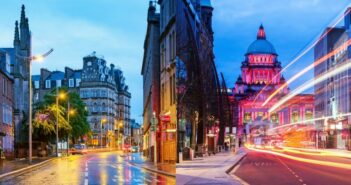The University of San Diego brought interested students, myslef included, on a January intersession to Manila and Hong Kong. This post focuses on impressions of the city of Hong Kong, especially as they relate to the topic of sustainable real estate; in this case the sustainability of the entire metropolitan system. Into the future, Hong Kong will be a living test-case for the effectiveness of various sustainability and modern metropolitan organization techniques and design.
The most striking aspect of the city is certainly its vertical density. A consequence of need, most of the metropolitan area does not fall under building height restrictions (areas of exception include the famous Hong Kong Island ridgeline). Hong Kong must deal with one of the highest population densities in the world, total land/population density was 6,540 persons per square kilometer in mid-2010 and Kwun Tong was the city’s most densely populated district at an incredible 54,530 persons per square kilometer (with a total population of 7,067,800 at that time)[1]. The only feasible way to support such population levels on land tightly restricted by natural terrain is to build up.
The benefits of density and vertical building are explored in depth in Edward Glaeser’s Triumph of the City, among these benefits is the relative environmentally sustainable qualities that are inherent to such a city. Because walking and public transit are preferred means of travel in dense urban systems, car pollution is theoretically reduced relative to cities with populations that must commute significant distances to their place of work. However, this condition is not currently realized in Hong Kong. In fact Hong Kong, like many Chinese cities, is known for its low air quality and pollution issues. The causes are attributed to a trifecta of coal-fired power plants, smog from mainland factories outside the city, and traffic pollution[2]. Hong Kong does not lack for public transportation, the MTR subway system and interconnected network of subterranean walkways are truly world class and bus networks and locally famous ding-ding trolleys all combine to publicly move 90% of Hong Kong’s 11 million daily trips[3]. Given the effectiveness of its public transit systems Hong Kong’s pollution issues seem to stem more from the coal energy and low factory standards culture currently present in China.
In addition to low reliance on personal vehicles, cities that concentrate their populations vertically cover a smaller footprint of natural land than those that sprawl. The consequence in the case of Hong Kong is an incredible amount of natural terrain that is not developed and serves as beautiful natural resources; beaches, hiking trails, mountains, and semi tropical forests immediately border the urban density of central Hong Kong. This circumstance may be attributable to the difficulties of developing on the land that surrounds the central city of Hong Kong/Kowloon, however leaders the world over would do well to notice the benefits and replicate where possible even if land is ideal for development.
Another important characteristic of Hong Kong is its intelligent and conscious decision to be visitor-friendly. This decision is most obvious in the incredibly well organized MTR, subterranean walkways and street signs. The entire subterranean system is navigated by grid designation; your destination, be it a general area or specific point of interest, with be labeled with a letter-number designation. When combined with frequent signage and arrow the effect is a system that is truly approachable and thus a city that is highly navigable even for a visitor facing their first day in Hong Kong. This may not be an issue of sustainability from an environmental or energy consumption perspective, however cities must maintain their populations in order to stay viable and attractive as places to live. As the world becomes more tightly knit due to decreasing transport costs and the increasingly global nature of business, Hong Kong has poised itself to benefit as an attractive and comfortable place to live for expats. This will likely serve to sustain the city as an economic powerhouse and the very best destination for business that occurs between East and West.
Hong Kong was a striking, eye-opening experience. Clearly built with vision, Hong Kong’s leadership has done an incredible job of controlling those aspects of the city that benefit from government leadership (the public transit and road networks, the airport and seaports) and getting out of the way of developers to allow the city to grow to it potential. The density of the city pushes the limits of what people have experienced at any time in history, for this reason it will be interesting to watch future growth, certainly the city will reach an unsustainable population level if innovations in living space cannot keep up with population influx. Hopefully the city will benefit from changes in the pollution culture of China; in the future China will be forced to address its unprecedented pollution levels (if for no other reason than the health impact it is having on its people). If external elements improve, Hong Kong will become a much cleaner city and a model for the environmental benefits of comprehensive, modern public transit systems. Hong Kong currently stands as a modern model of metropolitan success, its future should be watched closely, its best attributes replicated the world over.
[1] « Hong Kong Fact Sheets – Population. » 2007. 31 Jan. 2013 <http://www.gov.hk/en/about/abouthk/factsheets/docs/population.pdf>
[2] « Hong Kong smothered in worst air pollution two years | Reuters. » 2012. 31 Jan. 2013 <http://www.reuters.com/article/2012/08/02/us-hongkong-pollution-idUSBRE8710IA20120802>
[3] Lo, HK, and HK Lo. « Managing the accessibility on mass public transit – Journal of … » 2008. <https://www.jtlu.org/index.php/jtlu/article/viewPDFInterstitial/85/35>
Image credit : Photobank gallery
Tony Konstant is currently receiving his master of Science in Real Estate at University of San Diego. He is also a guest curator for the MIPIM sustainability and innovation category on behalf of the University of San Diego, Burnham-Moores Centre for Real Estate.



